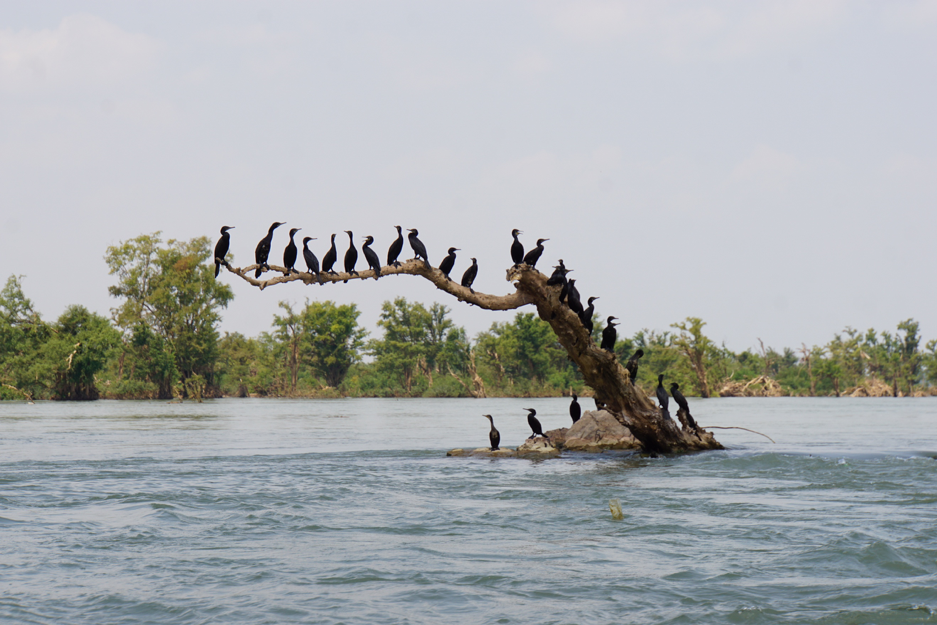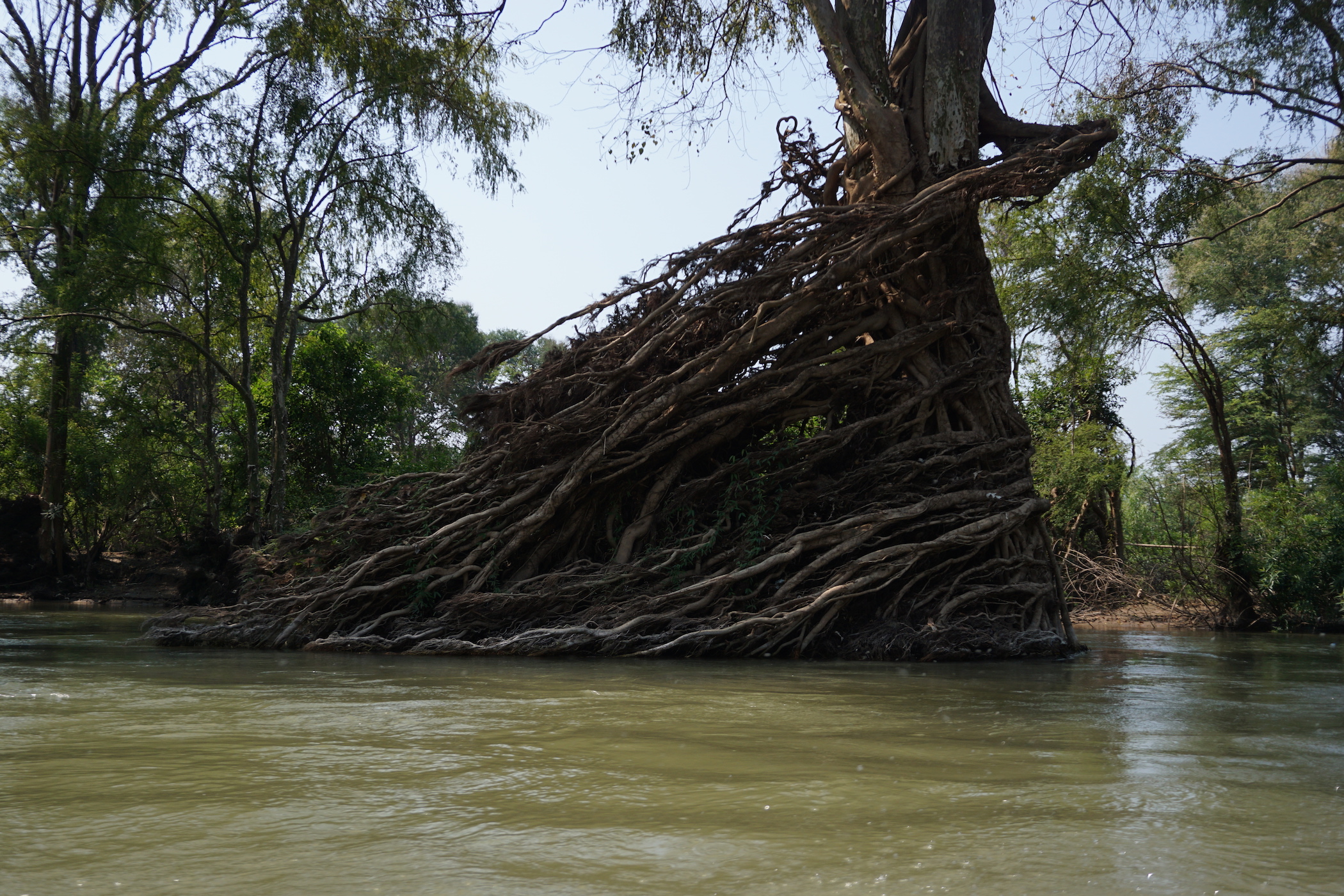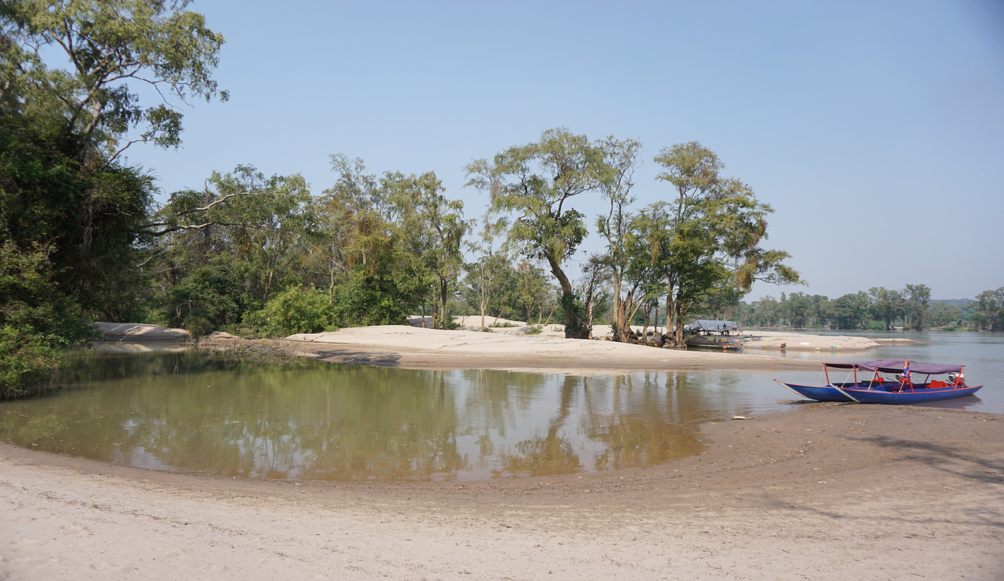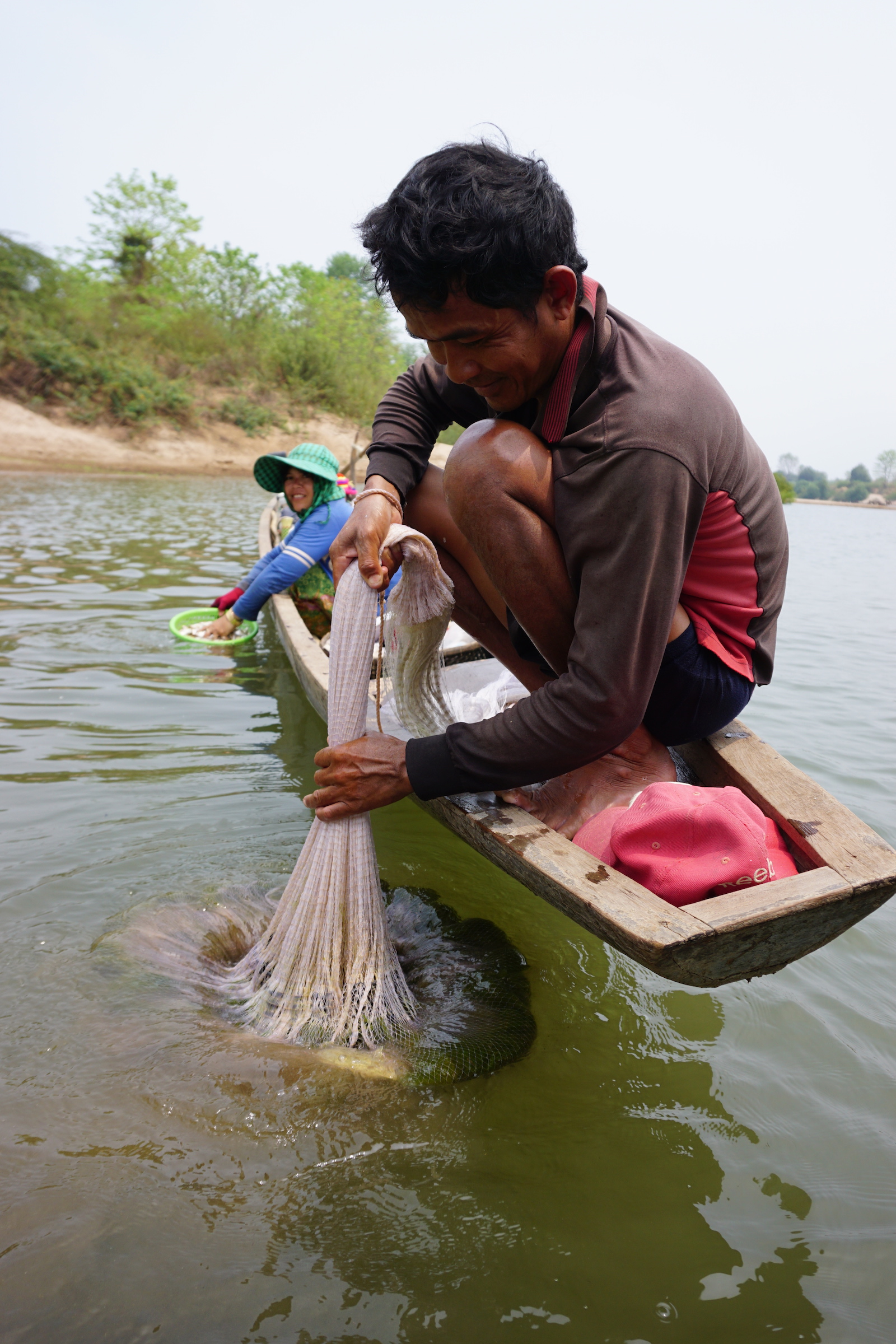
by Chea Seila
Wetlands are ecosystems that are covered with water permanently or for periods of time. Wetlands can be freshwater, saltwater, or a mix of both (called brackish water) and either natural or human-made, such as rice paddies, reservoirs, or ponds.
As a signatory country of the Ramsar Convention, Cambodia has identified five important wetlands covering 85,235 ha in various locations of the country, such as Tonle Sap Lake, the Mekong River, and coastal regions. The Tonle Sap area consists of three Ramsar Sites: Beung Tonle Chhmar and Stung Sen in Kampong Thom Province, and Prek Toal in Battambang Province. The Mekong region covers Stung Treng Ramsar Site extending along the Mekong in Stung Treng Province; and Koh Kapi Ramsar Site in Koh Kong Province.
All of the wetlands are connected to livelihoods of local people. They provide food and herbs for medicine and human well-being. In addition, the values of wetlands offer opportunities for education and research to students as well as both local and international researchers, and also provide authentic landscapes for tourists to enjoy.
Stung Treng Ramsar site stretches 37 km along the Mekong River and covers 14,600 ha. It is located 5 km from Stung Treng town and 2-3 km from the border with Lao PDR. It was officially registered as a Ramsar site in 1999. The Stung Treng Ramsar site is important to our environment because this wetland contains a catchment of ponds and creeks that can absorb or mitigate floods. It is also a main source of water for agriculture and offers important habitats and feeding places for many aquatic animals, such as fishes, birds, mammals, and insects. The wetlands are also home to flooded forests, which include some kinds of endangered plant and animal species, such as the critically endangered white shouldered Ibis (Pseudibis davisoni).
The aquatic habitats of Stung Treng Ramsar site combine deep pools, rapids, whirlpools, and rocky channels, which provide benefits such as fish spawning grounds and habitats. Furthermore, many small and large islands and sand bars with flooded forests grow along the waterway and provide good scenery compared to other wetlands.
A study by Salaphoum in 2007 found 130 fish species in 4 villages along the Stung Treng Ramsar Site, and the Stung Treng Management Plan (2015-2019) indicates that it is home to 207 fish species, 231 bird species (such as vultures, egrets, Grey-headed Fish Eagle, River Tern, Green Peacock, Darter, and Indian Cormorant), 42 reptile species, and some mammals.

Everyone is welcome to visit the unique Stung Treng Ramsar site and study it to further understand its natural resources, and join hands to protect and conserve these resources. I interviewed Mr. Nin Pisey, the director of Stung Treng Ramsar Site, and Mr. Phouk Nimol, a ranger with the Stung Treng Provincial Department of Environment, to learn about the best times for tourists to visit the site. We would like to invite tourists to visit the Stung Treng Ramsar site based on the seasonal activity calendar below:
- February to May: Bird watching, boat tours along the river to see the flooded forest and rapids, lunch on islands. There are many kinds of tree species to see, such as Raing (Barringtonia asiatica), Anchaeng, Thmear, Kros, Rei, Pring Tek, and grasses. Anchaeng trees grow up along the river channels, and their roots follow the water flow like the beautiful long hair of ladies blowing in the wind. The flooded forest provides leaves, flowers, and fruits that serve as food for people, birds, and fish, such as Tonlea fruit and the flowers of Andaeng.
- November to December: Villagers collect crickets from sand islands to eat at home. Tourists can taste the fresh natural fruits on the islands, such as watermelon, corn, oranges, and sweet Jamaica (Pek Kouk)
- Tourists, students, or researchers who are interested to observe livelihoods of local people or study about fish species can come to stay in a homestay with local people and join in their fishing during the following times to observe these species:
- July to September for Trey Trasak
- September for Trey Kaek
- November for Trey Pava, Trey Kes Chomrov, Trey Klaing Hay, Trey Prama
- November to January for Trey Pasee
On behalf of researchers and officials working in Stung Treng Ramsar Site, I would like to appeal to everyone to protect, conserve, and make wise use of resources in the Stung Treng Ramsar site and other wetlands in a sustainable way. Please keep in mind that these natural resources are for all!
Chea Seila is a 2018-2019 Mekong Conservation Hero selected by the Wonders of the Mekong project.

សូមអញ្ជើញទៅទស្សនាតំបន់រ៉ាមសារស្ទឹងត្រែង
ដោយ លោកស្រីជា សីលា
តំបន់ដីសើម គឺជាប្រព័ន្ធអេកូឡូស៊ី ដែលគ្របដណ្តប់ដោយដែនទឹកពេញមួយឆ្នាំ ឬ រយៈពេលជាក់លាក់ណា មួយ។ តំបន់ដីសើម អាចស្ថិតនៅក្នុងប្រព័ន្ធអេកូឡូស៊ីដាច់ដោយឡែកពីគ្នា ដូចជានៅក្នុងតំបន់ទឹកសាប តំបន់ទឹកប្រៃ ឬទឹកភ្លាវ និងតំបន់ដែលបង្កើតឡើងដោយមនុស្ស ដូចជាអាងស្តុកទឹក និងតំបន់វាលស្រែ។ល។
ក្នុងនាមជាប្រទេសហត្ថលេខីនៃអនុសញ្ញារ៉ាមសារ កម្ពុជាបានកំណត់តំបន់ដីសើមចំនួន៥កន្លែង ដែលគ្រប ដណ្តប់ លើផ្ទៃដីសរុបចំនួន ៨៥២៣៥ ហិកតា ស្ថិតនៅក្នុងតំបន់ផ្សេងៗគ្នា នៃប្រទេសកម្ពុជា មានដូចជា៖ តំបន់រ៉ាមសារ បឹងទន្លេសាប មានបីតំបន់គឺ តំបន់រ៉ាមសារបឹងទន្លេឆ្មារ តំបន់រ៉ាមសារស្ទឹងសែន ក្នុងខេត្តកំពង់ធំ និង តំបន់រ៉ាមសារ ព្រែកទាល់ ឬ តំបន់ឋបនីយជីវមណ្ឌលជម្រកសត្វស្លាប ព្រែកទាល់ ក្នុងខេត្តបាត់ដំបង។ តំបន់ រ៉ាមសារទន្លេមេគង្គ មានមួយតំបន់គឺតំបន់រ៉ាមសារស្ទឹងត្រែង។ តំបន់រ៉ាមសារតំបន់ឆ្នេរមានមួយតំបន់គឺ តំបន់ រ៉ាមសារកោះកាពិ ក្នុងខេត្តកោះកុង។
តំបន់រ៉ាមសារស្ទឹងត្រែង ដែលស្ថិតនៅតាមដងទន្លេមេគង្គ មានទំហំ១៤៦០០ហិកតា លាតសន្ធឹងប្រវែង៣៧ គីឡូម៉ែត្រ។ ក្នុងនោះ មានទីតាំងប្រមាណ៥គីឡូម៉ែត្រ ខាងលើទីរួមខេត្តស្ទឹងត្រែង និងប្រវែង ២ ទៅ៣គីឡូម៉ែត្រ ជាប់នឹងព្រំប្រទល់នៃសាធារណៈរដ្ឋប្រជាមានិតឡាវ និងបានចុះក្នុងបញ្ជីតំបន់ដីសើមអន្តរជាតិ (អនុសញ្ញា រ៉ាមសារ) ក្នុងឆ្នាំ១៩៩៩។ តំបន់រ៉ាមសារស្ទឹងត្រែង មានសារៈសំខាន់ណាស់សម្រាប់បរិស្ថាន។ តំបន់នេះ មាន ទីជម្រាល និងផ្ទៃរងទឹកភ្លៀង បឹងបួរ អូរ ដែលអាចជួយកាត់បន្ថយហានិភ័យ គ្រោះមហន្តរាយនៃទឹកជំនន់ និងជាប្រភពទឹក សម្រាប់ប្រើប្រាស់ក្នុងវិស័យកសិកម្ម ភាពសម្បូរបែបនៃជីវៈចម្រុះ ព្រមទាំងបានផ្តល់ជាជម្រក កន្លែងបង្កកំណើត និង រកចំណីសម្រាប់ធនធានជលផល សត្វស្លាប ថនិកសត្វ ល្មូន សត្វល្អិត និង ព្រៃលិចទឹក ជាពិសេស ពពួករុក្ខជាតិ និងប្រភេទសត្វកម្រ ឬ ងាយរងគ្រោះនានា។
តំបន់ដីសើមទាំងនេះ បានផ្សារភ្ជាប់ទៅនឹងរបរចិញ្ចឹមជីវិត និងប្រពៃណីវប្បធម៌របស់ប្រជាជនមូលដ្ឋាន។ វា បានផ្តល់ជាចំណីអាហារ ត្រី សាច់ បន្លែ និងរុក្ខជាតិសម្រាប់ផ្សំជាឱសថបុរាណ ។ បន្ថែមពីលើនេះ តំបន់រ៉ាមសារក៏ មានតម្លៃលើការអប់រំ និងការសិក្សាស្រាវជ្រាវ សម្រាប់ក្រុមនិស្សិត ឬអ្នកស្រាវជ្រាវជាតិ និងអន្តរជាតិ ព្រមទាំងវាបានផ្តល់ នូវសោភ័ណ្ឌភាព និងទេសភាព សម្រាប់ទាក់ទាញភ្ញៀវទេសចរជាតិ និងអន្តរជាតិ មកកំសាន្ត ផងដែរ។
 ប្រព័ន្ធអេកូឡូស៊ីតំបន់រ៉ាមសារស្ទឹងត្រែង មានលក្ខណៈពិសេស ដោយសារវាមានអន្លង់ទឹកជ្រៅៗ មានថ្មប៉ប្រះទឹក ទឹកវិល ទឹកជួរ ដែលជាអំណោយផល់ដល់ត្រីមេពូជបង្កកំណើត និងរស់នៅ។ ក្រៅពីនេះ មានកោះតូច-ធំ វាលខ្សាច់ មាន ព្រៃលិចទឹកតូច-ធំ យ៉ាងល្អប្លែកភ្នែក ជាងតំបន់ដទៃទៀតនៅក្នុងប្រទេសកម្ពុជា។
ប្រព័ន្ធអេកូឡូស៊ីតំបន់រ៉ាមសារស្ទឹងត្រែង មានលក្ខណៈពិសេស ដោយសារវាមានអន្លង់ទឹកជ្រៅៗ មានថ្មប៉ប្រះទឹក ទឹកវិល ទឹកជួរ ដែលជាអំណោយផល់ដល់ត្រីមេពូជបង្កកំណើត និងរស់នៅ។ ក្រៅពីនេះ មានកោះតូច-ធំ វាលខ្សាច់ មាន ព្រៃលិចទឹកតូច-ធំ យ៉ាងល្អប្លែកភ្នែក ជាងតំបន់ដទៃទៀតនៅក្នុងប្រទេសកម្ពុជា។
តាមការសិក្សាស្រាវជ្រាវកន្លងមកដោយគម្រោងស្រាវជ្រាវសាលាភូមិ ឆ្នាំ២០០៧ បានបង្ហាញពីប្រភេទត្រី ប្រមាណ១៣០ប្រភេទ។ នៅក្នុងផែនការគ្រប់គ្រងតំបន់រ៉ាមសារស្ទឹងត្រែង (២០១៥ ដល់ ២០១៩) បានបង្ហាញពី ធនធានសំខាន់ៗនៅក្នុងតំបន់រ៉ាមសារដូចជា មានត្រីលើសពី២០៧ប្រភេទ ប្រភេទសត្វស្លាបប្រហែល ២៣១ ប្រភេទត្រូវបានកំណត់មាន ដូចជា ក្អែកទឹកធំ ក្អែកទឹកមធ្យម អកត្រីក្បាលប្រផេះ ស្មោញ កេងកងធំ រំពេទន្លេ ក្ងោក ត្មាតផេះ ត្មាតភ្លើង។ល។ បន្ថែមពីនេះទៀតនៅមានសត្វល្មូន៤២ប្រភេទ និងថនឹកសត្វរស់នៅក្នុង និងក្បែរតំបន់រ៉ាមសារស្ទឹងត្រែងផងដែរ។
យោងតាមប្រសាសន៍របស់លោក និន ពិសី នាយកតំបន់រ៉ាមសារស្ទឹងត្រែង និងលោក ភោគ និមល មន្ត្រី ឧទ្យានុរក្ស តំបន់រ៉ាមសារស្ទឹងត្រែង នៃមន្ទីរបរិស្ថានខេត្តស្ទឹងត្រែង បានបញ្ជាក់ថា អ្នកទេសចរណ៍អាច អញ្ជើញមកកំសាន្ត និង ស្វែងយល់ពីតំបន់រ៉ាមសារស្ទឹងត្រែង តាមប្រតិទិន រដូវកាលដូចខាងក្រោម៖
ក្នុងចន្លោះពីខែកុម្ភៈ ដល់ខែឧសភា អ្នកទេសចរណ៍អាចឃើញសត្វស្លាបចុះ មានដូចជា ៖ ហ្វូងក្អែកទឹក ស្មោញ និង ត្រយ៉ងចំកំកស។ មើលព្រៃលិចទឹកដុះក្នុងទន្លេ ឬ តាមកោះតូចធំៗ តាមថ្មបប្រ៉ះទឹក។ ព្រៃលិចទឹក មានដូចជា៖ ដើមអញ្ជែង ដើមធ្មា ដើមរាំង ដើមរៃ ដើមអណ្តែង ដើមជ្រៃ ដើមព្រីងទឹក ដើមក្រុស និងប្រភេទស្មៅ ដែល ខ្លះលិចបាត់ក្នុងទឹក ខ្លះងើបចេញពីទឹកត្រឹមពាក់កណ្តាលដើមនៅរដូវវស្សា ហើយងើបចេញពីទឹក និងចេញឬស ទៅដីរយីងរយោង។ ចំពោះដើមអញ្ជែងដែលដុះនៅកណ្តាលទន្លេ ឬ ច្រកទឹកហូរ ភាគច្រើន បានទន់ទេរតាម កម្លាំងខ្សែទឹកហូរ គយគន់យូរៗទៅ ប្រៀបបាននឹងសក់មនុស្សស្រីផាត់តាមកម្លាំងខ្យល់បក់។ ព្រៃលិចទឹកទាំងនោះ បានផ្តល់ជាផ្កា ស្លឹក ផ្លែសម្រាប់ជាចំណីមនុស្ស និង ត្រីផងដែរ ដូចជាផ្កាអណ្តែង និង ដើមទន្លាជាដើម។
អ្នកទេសចរណ៍ ដែលចង់ស្វែងយល់ពីជីវភាព ប្រពៃណីវប្បធម៌របស់អ្នកភូមិ អាចទៅចូលរួមនេសាទជាមួយ ពួកគាត់បាន ឬក៏បរិភោគត្រីស្រស់ៗ ដែលនេសាទបានពីទន្លេភ្លាមៗ មានដូចជាត្រីប៉ាសេអីុចាប់ពីខែវិច្ឆិកា ដល់ខែមករា ត្រីក្អែក ក្នុងខែកញ្ញា ត្រីក្របី ចាប់ពីខែកក្កដា ដល់ខែកញ្ញា ត្រីត្រសក់ ក្នុងខែវិច្ឆិកា ត្រីប៉ាវ៉ា ត្រីកេសជម្រៅ ត្រីក្លាំងហាយ ត្រីប្រម៉ា។ល។ អ្នកទេសចរណ៍ក៏អាចចូលរួមទៅបាចចង្រិតជាមួយអ្នកភូមិ នៅតាមកោះខ្សាច់ ចាប់ពីខែវិច្ឆិកា ដល់ខែធ្នូព្រមទាំងអាចទៅភ្លក់បន្លែ និងផ្លែឈើ មានដូចជា៖ ក្រូច ពោត ឪឡឺក ប៉ិគក់ ដែលដាំដុះដោយអ្នកភូមិ នៅតាមកោះ ។
ក្នុងនាមជាអ្នកសិក្សាស្រាវជ្រាវ និងជាមន្ត្រីជំនាញធ្វើការនៅក្នុងតំបន់រ៉ាមសារស្ទឹងត្រែង សូមអំពាវនាវដល់ ប្រជាពលរដ្ឋក្នុង និងក្រៅតំបន់ ចូលរួមថែរក្សា ការពារ អភិរក្ស និងប្រើប្រាស់ធនធាន ដែលមាននៅក្នុងតំបន់ ដីសើមប្រកបដោយចីរភាព និងភាពឈ្លាសវៃ។ ចូរចាំថា ធនធានធម្មជាតិទាំងអស់នេះជារបស់យើងទាំងអស់គ្នា។
លោកស្រី ជា សីលា គឺជាបុគ្គលឆ្នើម ប្រចាំឆ្នាំ២០១៨ -២០១៩ ក្នុងការអភិរក្សតំបន់ទន្លេមេគង្គដែលបានជ្រើសរើសដោយ គម្រោងអច្ឆរិយភាពនៃទន្លេមេគង្គ។